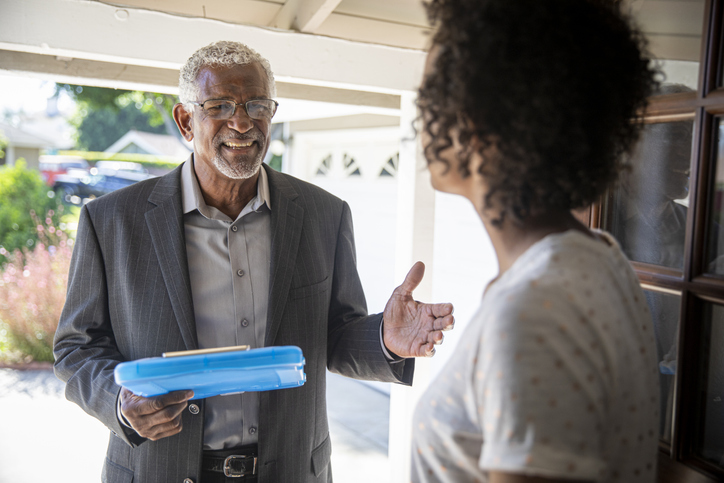
Use Canvassing to Mobilize Voters
Canvassing is special to me. I love knocking on doors. I think it is still a vastly underrated form of communication. Post COVID-19, canvassing is coming back in a big way and campaigns should plan for it now. Why do I think canvassing is so special? Because of the connection, direct contact grassroots combined with paid ads make with targeted voters in a personal and systematic way. With any paid medium you need repetition over a condensed period of time. With door-to-door contact, especially on political campaigns and with issue organizing, one good conversation can be enough to make a difference.
Door-to-door contact breaks down barriers
No matter where you are or who you are, door-to-door canvassing has a power that no other medium has. It can get people to actually talk to each other and break down any self-imposed barriers like party, race, gender, or identity. The conversation you can have at a door is a great equalizer—you are a walking change agent.
Canvassing forms unlikely connections
A door-to-door canvass done in the right way can create a connection between two people who may have never met and may never meet again, but that brief exchange of ideas can persuade someone in a way that a TV spot or a mail piece cannot. Whether it comes from a volunteer, candidate, or even a paid door-to-door canvasser, that connection can make a great impact.
Conversations at the door matter
The power of door-to-door contact comes from real engagement, not a lit drop or a rushed interaction with the candidate while they’re looking at their watch. The longer the conversation, the better.
Understanding the voter
Real connections happen when the conversation is about the voter. The dialogue at the door needs to be about the voter and the issues that matter to them, not about the candidate or the campaign.
A script can only get you so far
Think beyond the script. How do you draw in the voter to make a connection? Take notes, collect an email address, make it personal, and then follow up! The follow-up part is crucial and it can come as a post card, SMS, or as targeted digital ads.
No really, follow up!
The follow-up matters as much as the initial contact. If you said you were going to do something, do it. If you made a connection with someone, ask for their email address or send them a real, hand-written note. They will not forget it and you won't either. What you get from these conversations will influence your campaign and your work down the road, and we will all be better off. A real connection is hard to forget, both for the voter and the candidate. That is what makes it so powerful and so rewarding.
Actually knock on the doors
Tools can help you canvass, but you still need to actually knock on the doors. We love the door-to-door canvassing tools that are out there. Catalist, Grassroots Unwired, NGP VAN, SmartVAN, Organizer, and VoteBuilder all have tools that can help organize and support canvass programs, but they cannot make you knock on the doors and have those real conversations. You need those face-to-face interactions on a regular basis to make a difference.
Volunteers matter
Good volunteers have community relationships and can easily knock on doors and persuade voters due to their influence. If someone is volunteering for a local race, their neighbors will trust them.
Real organizers can make a difference
A hybrid between paid and unpaid canvassing happens when volunteer canvasses are run by paid organizers. This is my favorite kind of canvass because it gives you the best of both operations—persuasive volunteers at the doors with professional organizers managing them.
Paid canvassing can persuade
Don’t have volunteers? You can have well-trained, paid canvassers do a good job for you and your campaign. Is a paid canvass as good as a volunteer canvass? No, but it can help your campaign because you can scale paid canvassing more than a volunteer-based effort.
Connect canvassing to events
Connecting canvassing to a candidate coffee can make a difference by helping a voter directly engage with a candidate. You can also discuss an early vote turnout rally at the doors to remind people to get their votes in early.
Have a voter-contact plan
Have a real plan to reach voters and stick with it. Canvassing can separate the winners from the losers. Knowing how many doors you need to knock on will make a big difference in your campaign. Check out this blog to learn how to calculate your vote goal.
Targeting Matters
People underestimate the need to target a canvass in general. But in primary, municipal, and down-ballot elections, it’s especially critical. You can use targeting to increase your universe of voters to reach or to connect with low-information voters. Reducing fall-off and drop-off by engaging with the right people can make the difference between winning and losing.
Does door-to-door replace other communication efforts?
You should spend a lot of time knocking on doors, but even if you do, you will not reach everyone you need to. A layered approach is the key to success. Have authentic conversations at the door and back those up with paid communications that have the same tone and messaging. Social media can also help but again, you need to have a high volume of contact for both paid and unpaid efforts to make the impact you need to win. Check out our collection of canvass scripts and frameworks here.